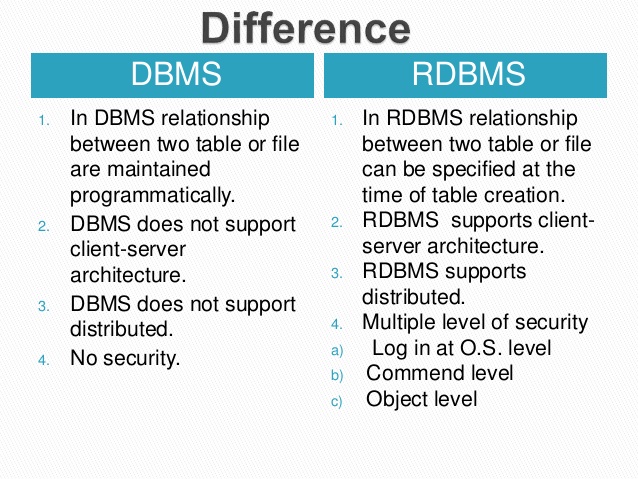DBMS & RDBMS

Database management system is a computer software component introduced during 1960’s. It is used for controlling various databases in the desktop computer or server. It was also termed as Navigational Database Management System. During 1970’s RDBMS or Relational database management system came into existence. We’ll see about RDBMS later in this article.
Database management system is the means of controlling databases either in the hard disk in a desktop system or on a network. Database management system is used for creating database, maintained database and provides the means of using the database. DBMS doesn’t consider relationship between the tables. Instead it will take the approach of manual navigation. This has led to severe performance problems when dealing with complex and high amount of data.
DBMS has several components. Some of the major components are external interface, database language engine, query optimizer, database engine, storage engine, DBMS management component, etc..
External Interface
External Interface is the user interface which is used to communicate with the DBMS as well as the databases.
Database language engine
Database language engine is the one which interprets the query language and do the necessary action supplied using the query language.
Query Optimizer
Query optimizer is used to optimize the supplied query language and identifies the best plan for executing the query and obtaining the result as fast as it could.
Database Engine
Database engine is used to create or manipulate the data in the database objects like table.
DBMS Management Component
DBMS Management Component comprises of several other components. They are used to take database backups, performance monitoring, security management etc.
Types of DBMS
There are several database management system models. Some of them are Navigational, RDBMS, SQL DBMS and� object-oriented databases. You can read more about the types of DBMS in my other article (Types of DBMS).
What is RDBMS?
RDBMS is the abbreviated form of Relational DataBase Management System.
Relational database management system was introduced in 1970’s. RDBMS avoided the navigation model as in old DBMS and introduced Relational model. The relational model has relationship between tables using primary keys, foreign keys and indexes. Thus the fetching and storing of data become faster than the old Navigational model. So RDBMS is widely used by the enterprises and developers for storing complex and large amount of data.
RDBMS table relationship diagram
Database Management System vs. Relational Database Management System:
The below table lists downs some of the major differences between DBMS and RDBMS.
Sl.# DBMS RDBMS
1 Introduced in 1960s. Introduced in 1970s.
2 During introduction it followed the navigational modes (Navigational DBMS) for data storage and fetching. This model uses relationship between tables using primary keys, foreign keys and indexes.
3 Data fetching is slower for complex and large amount of data. Comparatively faster because of its relational model.
4 Used for applications using small amount of data. Used for huge applications using complex and large amount of data.
5 Data Redundancy is common in this model leading to difficulty in maintaining the data. Keys and indexes are used in the tables to avoid redundancy.
6 Example systems are dBase, Microsoft Acces, LibreOffice Base, FoxPro. Example systems are SQL Server, Oracle , MySQL, MariaDB, SQLite.